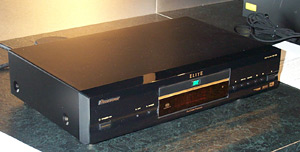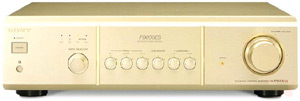![[SoundStage!]](../sslogo3.gif) Surrounded! Surrounded!Back Issue Article |
June 2002 A Flexible Multichannel System You Can Live With You want to experience multichannel music, but you also want to have a basic home theater and continue to enjoy your CD collection in good-old-fashioned stereo; but you don’t want to spend a lot of money, you don’t want to sacrifice sound quality, and you don’t want 16 boxes piled up in your living room. Don't panic! I have a three-box solution for you -- not counting speakers. OK, four boxes, tops. Let’s start at the beginning Start with the source -- always a good rule in audio. What you want is a DVD player. But here's the tricky part: you don’t want just any DVD player, but a DVD player with built-in Dolby Digital and DTS processing. That's on-board processing, not simply the ability to output a Dolby Digital or DTS signal to an external decoder. This is crucial. It means that the player provides almost all of the DVD-based home-theater functionality. The player incorporates your basic 5.1 surround processing, which is, after all, what you’ll use most of the time when watching movies. DVD players with built-in processing have six line-level outputs on their rear panels, so if you don't see them, you're not looking at the right DVD players. There are many good players that do not offer internal processing, but if you want to keep your life (and system) simple, you need one that does. You'll also need a unit that offers either DVD-Audio or SACD -- or both -- if you want to experience high-resolution multichannel music. (For an explanation of the many competing, and in many instances, co-existing technologies, see the December 2001 "Surrounded.") The newest source components feature an increasing amount of format compatibility and this is a boon for consumers.
No matter who makes it, choose a solidly constructed player with the functions you want. Consumers are demanding units that play everything, no matter who invented the format -- and manufacturers are beginning to listen. Whether you listen to DVD-A or multichannel SACD, you’ll be using the six-channel analog outputs, which is convenient because these same outputs will serve for your home-theater needs as well. The Technics unit I own uses a single set of six-channel outputs for both DVD-A and DVD-V’s Dolby Digital and DTS, but that’s not all: the front left and right outputs are also used when playing back stereo recordings. In my situation, a single set of six-channel outputs covers home theater, multichannel music, and standard CD. Where from there? Some players, such as Sony’s multichannel SACD players, have on-board bass management. This is the ability to route low bass into the most appropriate speakers, probably your subwoofer, or at least the most capable speaker in your setup, which, if you're not using a sub, will be the main stereo pair. The newer-generation players are beginning to incorporate on-board bass management, and the trend seems to be toward adding more flexibility in on-board bass-management options -- decidedly good news! If you own a player that doesn’t boast such facilities, the Outlaw ICBM represents an economical add-on solution (this is the fourth box I alluded to earlier). But no matter how you solve your bass-management requirements, you'll also need something to control the whole system and power the speakers. If you’re designing your system from scratch and don’t already own any stereo or multichannel components, it doesn't make sense to spend money duplicating functions your nifty new source player (the one from paragraph two) already supplies. So get exactly what you need, but not a bit more. At a retail price of $750, the Sony TA-P9000ES multichannel preamp fits the bill perfectly.
The end, my friend… Thanks to the home-theater phenomenon of the last few years, the final component in the electronics chain is easy to find. As recently as five years ago, it seemed like all you could buy were single-channel (monoblock), stereo (two-channel), and three-channel power amplifiers. Nowadays, multichannel amplifiers (five channels and even six or seven channels, in some cases) are a well-established component category and are available in plentiful supply from nearly every manufacturer. Even better, over the years multichannel amplifiers have not only become pretty darn good, but good values as well. You can pick up a monstrously powerful (225W x 5) Anthem MCA 50 for under $2000 that would do any music system justice. There are less expensive options, mind you -- and many which are more expensive, too -- but you can suit almost any budget, power requirement, or system configuration demand these days without having to improvise. You will need six pair of interconnects for this menagerie (nine if using the Outlaw ICBM): three sets to connect the source player to the multichannel preamp and the same again to go from preamp to multichannel power amp. Look on the bright side, though -- if you ever need to escape from a mountaintop prison, you can just tie them all together and lower yourself to freedom. More to come? You betcha! There are more components on the horizon that fit the system model discussed above. There'll be throngs of universal audio players joining the likes of the Pioneer DV-47A, more six-channel preamps (like the upcoming Bel Canto Design PRe6) to give the Sony some company, and plenty of multichannel amplifiers to drive that surround system. I wouldn’t be surprised to see a much deeper manufacturer commitment to user-friendliness and real-world functionality either. Anyway, there's your three-box solution (four, with the Outlaw ICBM) that delivers home theater, two-channel CD, and multichannel music. And believe me, a system like this can sound wonderful and be a snap to use. The payoff Now that you've assembled this system, you're ready to experience the pulse-pounding excitement of the Roman Legion's battle against the barbarian tribes in Gladiator, or hear what it was like to sit in the audience at Chesky’s Swing Live DVD-A recording as it was happening, or explore over a thousand years of music's greatest moments on CD. When your system doesn't dictate what you listen to, or how, the possibilities are without limit. ...Jeff Fritz
|
|
![[SoundStage!]](../sslogo3.gif) All Contents All ContentsCopyright © 2002 SoundStage! All Rights Reserved |
 Brand-new DVD players, such as
the Pioneer DV-47A, frequently feature multichannel SACD, in addition to DVD-A and DVD-V.
You can also find players that omit DVD-A in order to feature multichannel SACD. These
last tend to be from Sony, creators of the SACD format.
Brand-new DVD players, such as
the Pioneer DV-47A, frequently feature multichannel SACD, in addition to DVD-A and DVD-V.
You can also find players that omit DVD-A in order to feature multichannel SACD. These
last tend to be from Sony, creators of the SACD format. The TA-P9000ES has two sets of six-channel inputs that are routed through a
high-quality volume control as well as a set of two-channel and six-channel inputs that
bypass volume (but can be switched, in case of multiple sources). On the output side of
things, you get one set of eight-channel outputs (enough for two subs and two
center-channels). You can dial-in the appropriate levels for each channel through
individual level controls for the subwoofer, left and right surrounds, and the center
channel, all relative to the main front left and right channels. Once you’ve balanced
all the levels so they work well together, a master volume control will keep them in
perfect symmetry as you raise and lower the volume. Simple yet highly functional, the Sony
TA-P9000ES is easy to use and sounds great too.
The TA-P9000ES has two sets of six-channel inputs that are routed through a
high-quality volume control as well as a set of two-channel and six-channel inputs that
bypass volume (but can be switched, in case of multiple sources). On the output side of
things, you get one set of eight-channel outputs (enough for two subs and two
center-channels). You can dial-in the appropriate levels for each channel through
individual level controls for the subwoofer, left and right surrounds, and the center
channel, all relative to the main front left and right channels. Once you’ve balanced
all the levels so they work well together, a master volume control will keep them in
perfect symmetry as you raise and lower the volume. Simple yet highly functional, the Sony
TA-P9000ES is easy to use and sounds great too.